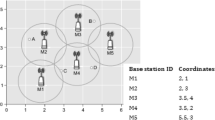Abstract
Quality of service (QoS) has been always controversial in resource shared networks. Scheduling as a packet prioritizing mechanism at Data Link Layer (DLL) contributes to QoS guarantee provisioning significantly. In this paper, a novel packet scheduler is developed in wireless cellular networks. The proposed scheme provides QoS-guaranteed service for the applications running on the sensor nodes in all the three aspects of QoS, i.e. data rate, packet loss and packet delay with regard to jitter simultaneously. We establish a three-dimensional space with certain basis vectors for QoS and introduce the efficient point of performance in terms of QoS provisioning in that space. Then we develop a generalized metric, the QoS-deviation, which is the Euclidean distance between the QoS work point of flows and the QoS efficient point in the proposed space. Based on this metric, a novel scheduling approach, namely AQDC, is designed which makes it possible to tune the trade-off between QoS provisioning and throughput optimization in an adaptive manner depending on the current Cell QoS-deviation level (CDL). Furthermore, we also develop another scheduler, namely ARTC, which is the residual-time version of the AQDC scheduler. Finally, a QoS-deviation-based CAC policy will be introduced which can be applied to all schedulers without any consideration about their structure and can be employed in cellular packet switched networks.





















Similar content being viewed by others
Notes
Here we consider the residual-time as a deadline for the transmission of flows.
This metric and its dependent schedulers have been previously presented by the authors at AINA’07 conference. See [20].
HOL packet is the first one in the packet queue of each flow.
The typical value for the p_step parameter is 10% of the initial value of the p parameter at the start of the algorithm (p 0 ).
50% violation in QoS means r(t) = 1.5, d(t) = 1.5, l(t) = 1.5. Substituting these values into Eq. 12, we have: \( \sqrt {\left( {r(t) - 1} \right)^{2} + \left( {d(t) - 1} \right)^{2} + \left( {l(t) - 1} \right)^{2} } = \sqrt {3 \times \left( {0.5} \right)^{2} } \cong 0.87. \)
Abbreviations
- 3D-QoS:
-
3D-quality of service
- CDL:
-
Cell QoS-deviation level
- CUL:
-
Cell urgency level
- AMC:
-
Adaptive modulation and coding
- CAC:
-
Call admission control
References
Huang, V., & Zhuang, W. (2004). QoS-oriented packet scheduling for wireless multimedia CDMA communications. IEEE Transactions on Mobile Computing, 3(1).
Liu, Q., Zhou, S., & Giannakis, G. B. (2005). Cross-layer scheduling with prescribed QoS guarantees in adaptive wireless networks. IEEE Journal on Selected Areas in Communications, 23(5).
Shakkottai, S., Rappaport, T. S., & Karlsson, P. C. (2003). Cross-layer design for wireless networks. IEEE Communication Magazine, 41(10), 74–80.
Liebeherr, J., & Christin, N. (2001). JoBS: Joint buffer management and scheduling for differentiated services. In Proceedings of IWQoS 2001 (pp. 404–418). Karlsruhe, Germany.
Wischhof, L., & Lockwood, J. W. (2001). Packet scheduling for link-sharing and quality of service support in wireless local area networks. Department of Computer Science, Applied Research Lab, Washington University.
Zhang, H. (1995). Service disciplines for guaranteed performance service in packet-switching networks. Proceedings of the IEEE, 83, 1374–1396.
Fattah, H., & Leung, C. (2002). An overview of scheduling algorithms in wireless multimedia networks. IEEE Wireless Communication Magazine, 9(5), 76–83.
Valentin, S., Gross, J. Karl, H., & Wolisz, A. (2005). Adaptive scheduling for heterogeneous traffic flows in cellular wireless OFDM-FDMA systems. IEEE Wireless Communication Magzine.
Caire, G., & Raj Kumar, K. (2007). Information theoretic foundations of adaptive coded modulation. IEEE Transactions on Wireless Communication, 95(12).
Liu, Q., Zhou, S., & Giannakis, G. B. (2005). Queueing with adaptive modulation and coding over wireless links: Cross-layer analysis and design. IEEE Transactions on Wireless Communication, 4(3).
Liu, Q., Zhou, S., & Giannakis, G. B. (2004). Cross-layer combining of adaptive modulation and coding with truncated ARQ over wireless links. IEEE Transaction on Wireless Communication, 3(5), 1746–1755.
Doufexi, A., Armour, S., Butler, M., Nix, A., Bull, D., McGeehan, J., et al. (2002). A comparison of the HIPERLAN/2 and IEEE 802.11a wireless LAN standards. IEEE Communications Magazine, 40(5), 172–180.
Physical Layer Aspects of UTRA High Speed Downlink Packet Access (Release 4), 2001. 3GPP TR 25.848 V4.0.0.
Physical Layer Standard for cdma2000 Spread Spectrum Systems, July 1999. 3GPP2 C.S0002-0, Version 1.0.
Karaoguz, J. (2001). High-rate wireless personal area networks. IEEE Communications Magazine, 39(12), 96–102.
Borst, S. (2003). User-level performance of channel-aware scheduling algorithms in wireless data networks. In Proceedings Infocom 2003, San Francisco, CA.
Liu, P., Berry, R., & Honig, M. L. (2003). Delay-sensitive packet scheduling in wireless networks. In Proceedings WCNC 2003. New Oreans, Lousiana.
Viswanath, P., Tse, D. N. C., & Laroia, R. (2002). Opportunistic beamforming using dumb antennas. IEEE Transactions on Information Theory, 48(6), 1277–1294.
Hartmann, C., Vilzmann, R., & Eberspacher, J. (2004). Channel aware scheduling for user-individual QoS provisioning in wireless systems. In Proceedings of IEEE vehicular technology conference, VTC2004 (pp. 1009–1013).
Kazemi, R., Yaghmaee, M. H., & Chitizadeh, J. (2007). Three dimension QoS deviation based scheduling in adaptive wireless networks. In Proceeding of 21st IEEE international conference on advanced information and networking applications (AINA’07), Ontario, Canada (pp. 588–595).
Wang, L., & Zhuang, W. (2006). A call admission control scheme for packet data in CDMA cellular communications. IEEE Transactions on Wireless Communication, 5(2).
Shakkottai, S., Rappaport, T. S., & Karlsson, P. C. (2003). Cross-layer design for wireless networks. IEEE Communications Magazine, 41(10), 74–80.
Ning, L., & Bigham, J. (2007). On utility-fair bandwidth adaptation for multi-class traffic QoS provisioning in wireless networks. Computer Networks, 51, 2554–2564.
Acknowledgment
The authors hereby wish to thank Mr. Behzad Abbasgholi for his valuable assistance, comments and guidelines that made this research better.
Author information
Authors and Affiliations
Corresponding author
Rights and permissions
About this article
Cite this article
Beidokhti, R.K., Yaghmaee Moghaddam, M.H. & Chitizadeh, J. Adaptive QoS scheduling in wireless cellular networks. Wireless Netw 17, 701–716 (2011). https://doi.org/10.1007/s11276-010-0308-5
Published:
Issue Date:
DOI: https://doi.org/10.1007/s11276-010-0308-5




